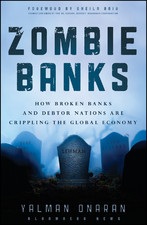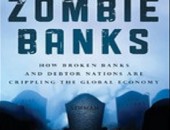George A. Romero, the moviemaker who popularized the witchcraft legend of the “walking undead,” would likely be astonished to hear the term applied to real financial institutions, but “Zombie banks” does capture the concept well.
On June 5, 2012, Yalman Onaran, author of “Zombie Banks: How Broken Banks and Debtor Nations Are Crippling the Global Economy,” and financial reporter at Bloomberg News, spoke at a panel convened by GARP (Global Association of Risk Professionals) to discuss the phenomenon of banks which exist to fulfill a regulatory purpose but are not in themselves economically viable. Onaran said the first response to the Financial Crisis of 2008 had been to make capital injections to banks, and now, in this time of very low interest rates, some banks must continue to be propped up “even though the investors don’t necessarily believe the book value” of the assets held by the bank.
The day’s second panellist, Edward Kane, was the first writer to coin the term “zombie bank” in describing the continued existence of savings & loans companies after the S&L crisis of 1980s and applying the concept to Japanese institutions that were having their own meltdown in 1992-3. Kane noted that the US S&L crisis was actually responsible for the first generation of zombie banks. (The undead were among us without our knowledge, I guess you could say.)
 Kane contrasted zombie banks with “real banks” that have a slow and steady stream of good lending, making responsible decisions that lead to jobs in the companies that are productively managing thgeir cash flows and debt loans. Zombie banks, on the other hand, don’t know and don’t care how the debt they are racking up will be supported. “And still, they figure the government will support them.” Short of forming Anti-Zombie Brigades, what can good citizens do?
Kane contrasted zombie banks with “real banks” that have a slow and steady stream of good lending, making responsible decisions that lead to jobs in the companies that are productively managing thgeir cash flows and debt loans. Zombie banks, on the other hand, don’t know and don’t care how the debt they are racking up will be supported. “And still, they figure the government will support them.” Short of forming Anti-Zombie Brigades, what can good citizens do?
The third panellist, Fred Cannon, director at Keefe, Bruyette & Woods, and an economist by training, noted that the housing market has yet to resolve some postponed debt issues. “There are still two huge shadow problems,” he cautioned. Delinquencies-in-progress and underwater mortgages could cause the banks holding them to implode if interest rates increase too quickly.
 Cannon said that global regulators are now highly focussed on tangible common equity, vis à vis the results from recent stress tests. He characterized regulators as being “one crisis behind”—as evidenced by the last draft of regulations, which were soft on mortgage debt and sovereign debt. Cannon favours a “tough love” approach to counteract the lack of market discipline. He says we need to allow banks to fail withouth having the entire system seize up when one failure happens. “Airlines go out of business every year,” said Cannon, “but that doesn’t mean airplanes fall from the sky.”
Cannon said that global regulators are now highly focussed on tangible common equity, vis à vis the results from recent stress tests. He characterized regulators as being “one crisis behind”—as evidenced by the last draft of regulations, which were soft on mortgage debt and sovereign debt. Cannon favours a “tough love” approach to counteract the lack of market discipline. He says we need to allow banks to fail withouth having the entire system seize up when one failure happens. “Airlines go out of business every year,” said Cannon, “but that doesn’t mean airplanes fall from the sky.”
Thank you, Mr. Cannon. What a succinct way to express what’s wrong with market discipline in the financial sector.ª
The GARP webinar presentation slides can be found at: http://www.garp.org/risk-news-and-resources/webcasts/on-demand-webcasts.aspx?page=1
The book by Yalman Onaran that is referenced can be found at: http://zombiebanks.org/
UPDATE: Headline news February 3, 2014 – Europe on the hunt for ‘zombie banks’

